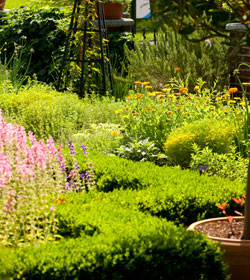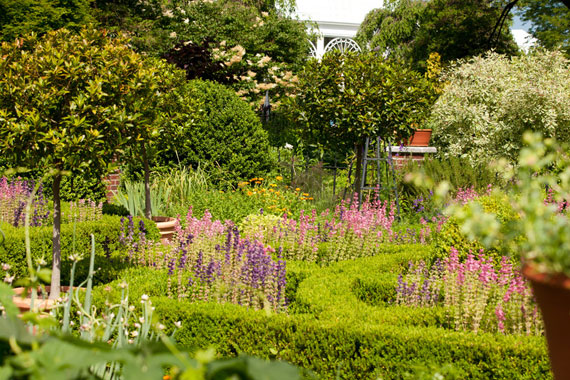Boxwood Comes Under Blows: Protect Your Landscape Against Blight
Posted in Horticulture on August 14 2014, by Don Gabel
Don Gabel is NYBG’s Director of Plant Health. He monitors, diagnoses, and prescribes treatments for all the plants growing on the grounds, as well as in NYBG’s beautiful gardens and glass houses. Don educates and provides horticultural advice to the staff as well as teaching the public about different aspects of horticulture. He lives in Rockland county New York.
 Here we go again! Just as we find a versatile, deer resistant, drought tolerant, easy-to-maintain landscape plant, a new pest problem emerges. Boxwood has been extensively planted over the last 20 years and I always say, “If you plant it they will come.” In late 2011, the pathogen causing boxwood blight (Cylindrocladium buxicola) was documented in the U.S. Since then it has been found in at least 5 states. This pathogen attacks the leaves and stems of boxwood, and a few related plants, eventually causing defoliation and death. The Northeast is full of mature specimen boxwood, and it is a popular landscape plant for new plantings, so there is a high potential for significant impact on landscape boxwood.
Here we go again! Just as we find a versatile, deer resistant, drought tolerant, easy-to-maintain landscape plant, a new pest problem emerges. Boxwood has been extensively planted over the last 20 years and I always say, “If you plant it they will come.” In late 2011, the pathogen causing boxwood blight (Cylindrocladium buxicola) was documented in the U.S. Since then it has been found in at least 5 states. This pathogen attacks the leaves and stems of boxwood, and a few related plants, eventually causing defoliation and death. The Northeast is full of mature specimen boxwood, and it is a popular landscape plant for new plantings, so there is a high potential for significant impact on landscape boxwood.
This disease began primarily as a nursery problem. Since then, it has spread to the landscape through new plantings of boxwood, and into the suburban landscape. When a single genus or species is over-planted in the landscape, eventually what were minor pests, or new invasive insects and diseases, can become major problems. The disease is now found in the landscape in western Connecticut as well as in Long Island and Westchester in New York. boxwood blight first appears as chocolate black spots on the foliage. In a few days the spots develop yellow to brown rings, eventually infecting the whole leaf. In a couple of weeks, the leaves die and fall off. The stem close to the infection can have black dead lesions or cankers.

If you have confirmed or suspect a case of this disease, it is best to consult a professional horticultural pest control expert, who can apply an appropriate fungicide. Plant health and good plant culture are essential in combating any pest problem. In addition to using a fungicide program, here are some other plant health tips to help control this aggressive disease:
- • Choose the proper sun exposure for the species you have. If you have to, prune existing trees to open up an area and create more light and air circulation.
- • Avoid cultivating in the root zone. Boxwood have a very compact, fibrous root system located near the soil surface
- • Monitor watering needs during time of prolonged dryness and, when needed, water deep and infrequently
- • Boxwood planted in the ground don’t need a lot of fertilizer. If you determine they do need fertilizer, then mid-to-late fall is the best time. Check the soil pH. It should be in the range of 6.5–7
- • Monitor for other key pests that may attack boxwood, such as leaf minor, spider mites, and diseases such as Volutella and phytophthora
- • When planting new boxwood, purchase clean stock from a reputable nursery. If possible, quarantine the new boxwood for some time to see if any symptoms appear
Europe has been battling boxwood blight for over 10 years. Good culture and a little fungicide give the U.S. ample tools to do battle, as well.

